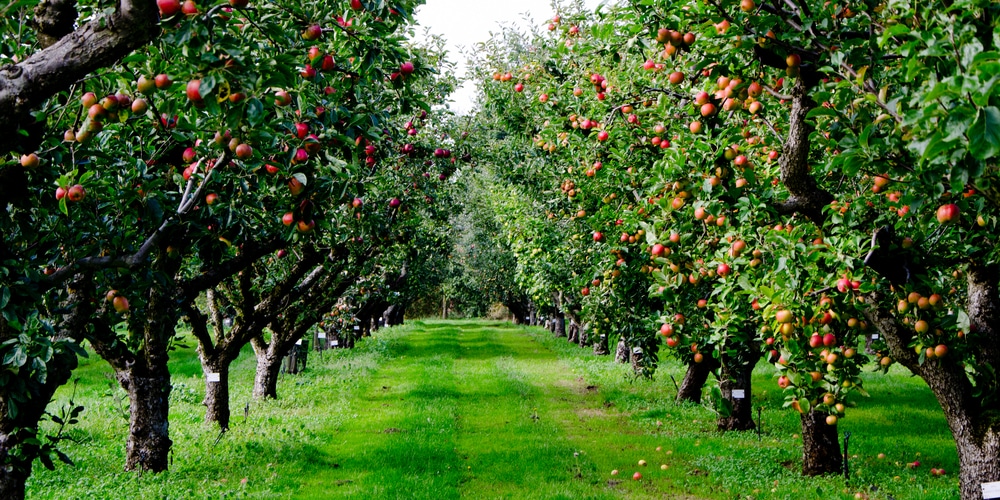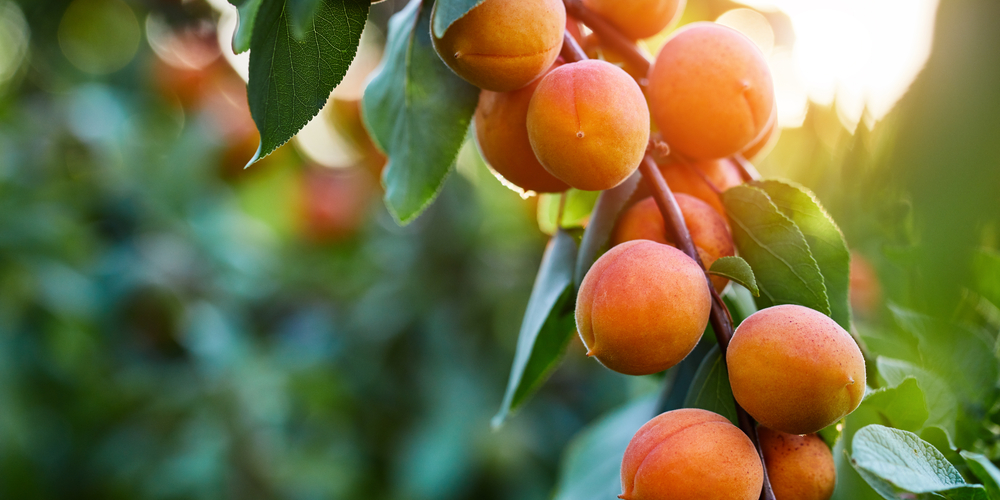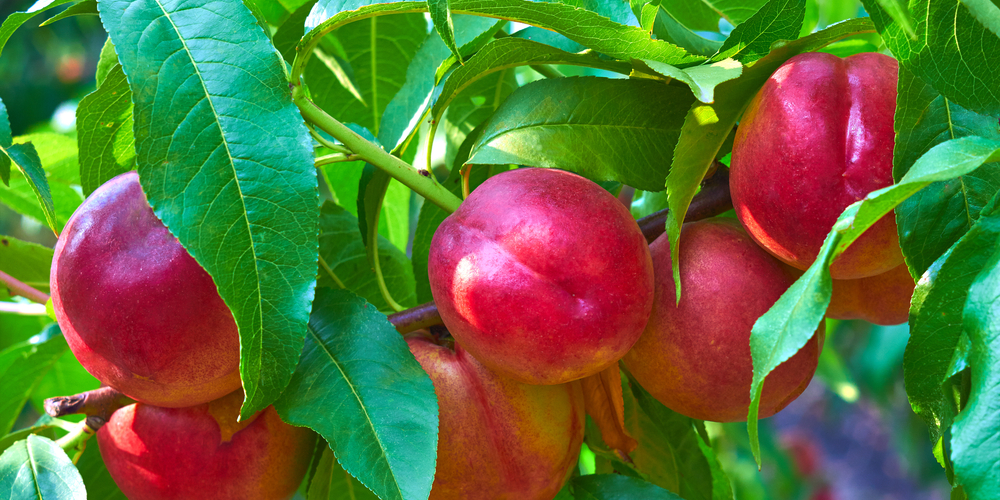According to the Indiana State Climate Office, “Indiana is situated in a region characterized as having a temperate climate.” What that means is that Indiana experiences hot summers and cool winters. The best fruit trees to grow in Indiana are plums, pears, and apples.
Plums require a pollinator tree, so you can buy two plum trees to increase the amount of fruit produced. Apples are generally easier to grow than plums; however, they require some pruning. Let’s look at the best fruit to grow in Indiana.
Apple Trees

An apple tree will produce sweet fruit that can be eaten or used for baking. There are many varieties of apple trees. The Granny Smith is a popular apple variety in Indiana.
This tree produces a green apple that tastes tart and sweet. A ripe Granny Smith is crisp and juicy, making it popular as a snack or ingredient in pies and desserts.
The Braeburn is another type of apple that does well in Indiana. The fruit on this tree is sweet and slightly tart. This variety is often eaten raw, but it can also be used for cooking or baking. The Braeburn has red skin with green stripes, giving it an odd appearance compared to other apple varieties.
Plums
Plums need another plum tree nearby to pollinate the flowers on the tree so that they develop into plums, so ideally, you’ll want two plum trees in your garden. Plums are self-fertile, which means they can pollinate themselves; however, having a second tree nearby will increase the number of plums produced by both trees.
Plums require a minimum chill hour range between 200 – 700 hours which is easily achieved in Indiana as it receives over 1,000 chill hours annually. The best time to plant these fruit trees is during the early fall or spring months, when plenty of rainfall is available to establish their root system.
Pear Trees
A pear tree will produce soft fruit that can be eaten fresh or cooked into jams and preserves. There are many varieties of pear trees, but the Bartlett is a popular variety. The Bartlett grows large, green pears that have a creamy white interior. These pears are ripe when they become soft and great for eating raw or cooking into desserts.
The Bartlett is resistant to fireblight disease, which is common with many other pear varieties, making it easier to care for and maintain throughout its life span. It’s one of the easiest fruit trees to grow based on resistance to diseases and pests.
Apricots
Apricots apricot trees need to be cross-pollinated with another variety or may not bear fruit. Though apricots can survive in Indiana’s climate, they are vulnerable to late spring frosts and can have a short lifespan. If you are looking for an easy-to-grow tree, consider an apple tree instead.
The best apricot varieties for Indiana are Rival and Goldcot. They require higher winter chill hours than our other fruits, so selecting a location with a high winter chill is essential. Plant them in full sun and well-drained soil. The tree will bear fruit within three years after planting.
Persimmon
Persimmons (Diospyros kaki) are large shade trees that grow up to 50 feet tall and produce orange-colored fruit in the fall. Plant them in full sun or partial shade in well-drained, moist soil.
Persimmons prefer the U.S. Department of Agriculture plant hardiness zones 6 through 9, although some varieties can be grown in zone 5. Persimmons are susceptible to aphid infestations, so use insecticidal soap on the tree to control these pests.
Japanese persimmons usually survive mild winters without protection, but colder winters may kill back the top growth. The tree comes back from the roots and flowers again, though it may produce less fruit than usual.
Figs
Figs (Ficus carica) are fast-growing deciduous trees that grow up to 30 feet tall and produce purple figs in mid-to-late summer. They prefer full sun and tolerate various soil conditions and drought, but they don’t thrive under soggy soil or severe winters.
Figs perform well in USDA zones 5 through 10, although they need protection from windy conditions if planted in zones 4 or 5. They must be protected with mulch or some other method during the winter in northern Indiana. Some figs can be grown in containers on patios or balconies, but they require six hours of direct sun and regular watering.
Mulberry
Mulberry trees are hardy in Indiana, and the fruit has a pleasantly sweet and tart flavor. These trees can grow quite large, so be sure you have the space to grow them. Mulberries do well in most soil types, and they can even thrive in barren soil where other trees struggle.
Mulberry leaves are green during the spring but turn a reddish-purple color in autumn. The mulberry tree produces small berries that are typically red or black but can also be white. The berries grow on long branches that can reach out as far as 6 feet from the trunk of the tree.
Nectarines
Nectarines are similar to peaches, but they don’t have fuzzy skin. They are sweeter than peaches and more delicate in texture. Nectarine trees produce both flowers and fruit on their outer branches.
They need full sun to thrive and be pruned in the early spring to encourage strong shoots and prevent fungal diseases, which can occur if their drooping branches touch the ground or other plants.
Nectarines need less care than peaches because they do not require regular pruning or spraying with pesticides.
Cherry trees are challenging to grow in Indiana
Cherry trees are challenging to grow in Indiana because they require many chill hours, which this state doesn’t have. The lack of chill hours prohibits the flowers from blooming in the spring. Cherry tree varieties that are cold-hardy for zone 5 include the North Star, Montmorency, and Meteor. Select sites that receive full sun and have well-drained soil. Plant cherries in early spring when the ground is workable.
Peaches are also challenging to grow in Indiana
Peaches are challenging to grow in Indiana due to fungal diseases that occur in moist environments, which this state has plenty of. Fungal infections on peach trees include brown rot, scab, leaf curl, and peach leaf curl. Peachtree varieties hardy for zone 5 includes Red Haven, Reliance, and Contender.
Takeaway
You should stick with growing the best fruit trees for Indiana’s climate – apples, pears, and plums. Of course, the perfect tree will depend on your personal preferences and available space. And even though we can’t guarantee success with any of these trees, they are as good a place to start as any and should fare well in Indiana regardless.
Related article: Best fruit to grow in zone 7b








